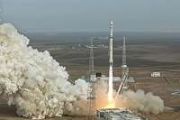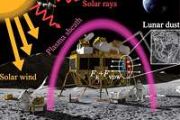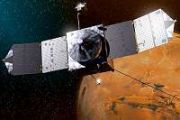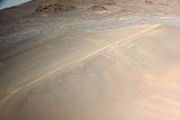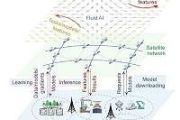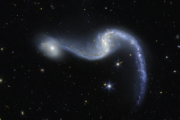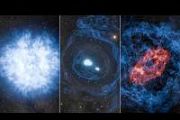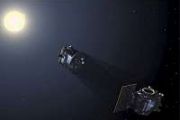
Copernical Team
Hidden chemistry of Earth core revealed through freezing process
 A new study by researchers from Oxford, Leeds, and University College London has uncovered fresh insights into Earth's core chemistry by showing how crystallisation became possible millions of years ago. Published in Nature Communications, the research indicates that Earth's core required 3.8% carbon content to begin freezing.
This finding suggests that carbon is more abundant in the core
A new study by researchers from Oxford, Leeds, and University College London has uncovered fresh insights into Earth's core chemistry by showing how crystallisation became possible millions of years ago. Published in Nature Communications, the research indicates that Earth's core required 3.8% carbon content to begin freezing.
This finding suggests that carbon is more abundant in the core AI powered SAR imagery analysis tool launched by SATIM and ICEYE
 SATIM and ICEYE have jointly introduced Detect and Classify, a product designed to automate analysis of Synthetic Aperture Radar (SAR) satellite imagery. The system identifies vessels, aircraft, and vehicles with accuracy exceeding 90 percent, reducing dependence on manual review and enabling defense and security organizations to act more quickly.
The product integrates ICEYE's high resolu
SATIM and ICEYE have jointly introduced Detect and Classify, a product designed to automate analysis of Synthetic Aperture Radar (SAR) satellite imagery. The system identifies vessels, aircraft, and vehicles with accuracy exceeding 90 percent, reducing dependence on manual review and enabling defense and security organizations to act more quickly.
The product integrates ICEYE's high resolu Second Meteosat Third Generation Imager completes thermal testing ahead of Ariane 2 launch
 The second Meteosat Third Generation Imager, MTG-I2, has cleared a key milestone in its preparation for launch after completing thermal vacuum testing at Thales Alenia Space's cleanroom facilities in Cannes, France. The satellite endured extreme simulated space temperatures from -180C to +150C, verifying its resilience in the geostationary environment.
Francesco Cainero, ESA's Lead Space S
The second Meteosat Third Generation Imager, MTG-I2, has cleared a key milestone in its preparation for launch after completing thermal vacuum testing at Thales Alenia Space's cleanroom facilities in Cannes, France. The satellite endured extreme simulated space temperatures from -180C to +150C, verifying its resilience in the geostationary environment.
Francesco Cainero, ESA's Lead Space S Earth wobble measured with unmatched precision by ring laser
 The Technical University of Munich has achieved a breakthrough in monitoring the Earth's axis, recording its subtle wobbles with a precision unmatched by previous instruments. Results of a 250-day experiment, published in Science Advances, demonstrate that the TUM ring laser provides accuracy 100 times greater than earlier gyroscopes or ring lasers.
Lead author Prof. K. Ulrich Schreiber of
The Technical University of Munich has achieved a breakthrough in monitoring the Earth's axis, recording its subtle wobbles with a precision unmatched by previous instruments. Results of a 250-day experiment, published in Science Advances, demonstrate that the TUM ring laser provides accuracy 100 times greater than earlier gyroscopes or ring lasers.
Lead author Prof. K. Ulrich Schreiber of Spire wins NOAA pair of satellite weather data contracts totaling 13.7 million
 Spire Global has secured two NOAA orders that together total $13.7 million, extending the company's role in supplying satellite-derived weather intelligence for U.S. government forecasting and research.
The larger award is an $11,190,900 task order for one year, running from Sep 18, 2025 through Sep 18, 2026, to deliver GNSS radio occultation (GNSS-RO) profiles of pressure, humidity, and t
Spire Global has secured two NOAA orders that together total $13.7 million, extending the company's role in supplying satellite-derived weather intelligence for U.S. government forecasting and research.
The larger award is an $11,190,900 task order for one year, running from Sep 18, 2025 through Sep 18, 2026, to deliver GNSS radio occultation (GNSS-RO) profiles of pressure, humidity, and t Gilat wins $7 million US defense contract for transportable SATCOM systems
 Gilat Satellite Networks Ltd. announced that its U.S. subsidiary, Gilat DataPath, has secured a contract exceeding $7 million to deliver transportable SATCOM terminals for the U.S. Department of Defense through a prime contractor. Deliveries of the systems are scheduled for completion by the end of 2025.
The order includes multiple DKET 3421 transportable terminals along with associated su
Gilat Satellite Networks Ltd. announced that its U.S. subsidiary, Gilat DataPath, has secured a contract exceeding $7 million to deliver transportable SATCOM terminals for the U.S. Department of Defense through a prime contractor. Deliveries of the systems are scheduled for completion by the end of 2025.
The order includes multiple DKET 3421 transportable terminals along with associated su New particle detector passes the 'standard candle' test
 A new and powerful particle detector just passed a critical test in its goal to decipher the ingredients of the early universe.
The sPHENIX detector is the newest experiment at Brookhaven National Laboratory's Relativistic Heavy Ion Collider (RHIC) and is designed to precisely measure products of high-speed particle collisions. From the aftermath, scientists hope to reconstruct the propert
A new and powerful particle detector just passed a critical test in its goal to decipher the ingredients of the early universe.
The sPHENIX detector is the newest experiment at Brookhaven National Laboratory's Relativistic Heavy Ion Collider (RHIC) and is designed to precisely measure products of high-speed particle collisions. From the aftermath, scientists hope to reconstruct the propert Chinese launch campaign places multiple satellites in orbit
 China carried out two successful launches on Friday from different spaceports, deploying a series of satellites into orbit for testing and operational missions.
Early in the day, at 10:34 am Beijing Time, a Long March 3C rocket lifted off from the Xichang Satellite Launch Center in Sichuan province. The launch carried the Shiyan 29 experimental satellite, supported by a Yuanzheng 1 upper s
China carried out two successful launches on Friday from different spaceports, deploying a series of satellites into orbit for testing and operational missions.
Early in the day, at 10:34 am Beijing Time, a Long March 3C rocket lifted off from the Xichang Satellite Launch Center in Sichuan province. The launch carried the Shiyan 29 experimental satellite, supported by a Yuanzheng 1 upper s Upcoming Launch to Boost NASA's Study of Sun's Influence Across Space
 Soon, there will be three new ways to study the Sun's influence across the solar system with the launch of a trio of NASA and National Oceanic and Atmospheric Administration (NOAA) spacecraft. Expected to launch no earlier than Tuesday, Sept. 23, the missions include NASA's IMAP (Interstellar Mapping and Acceleration Probe), NASA's Carruthers Geocorona Observatory, and NOAA's SWFO-L1 (Space Weat
Soon, there will be three new ways to study the Sun's influence across the solar system with the launch of a trio of NASA and National Oceanic and Atmospheric Administration (NOAA) spacecraft. Expected to launch no earlier than Tuesday, Sept. 23, the missions include NASA's IMAP (Interstellar Mapping and Acceleration Probe), NASA's Carruthers Geocorona Observatory, and NOAA's SWFO-L1 (Space Weat 50 years ago, NASA sent two spacecraft to search for life on Mars. The missions' findings are still discussed today
This request seems a bit unusual, so we need to confirm that you're human. Please press and hold the button until it turns completely green. Thank you for your cooperation!
Press and hold the button
If you believe this is an error, please contact our support team.
185.132.36.159 : 9f815824-1e2c-43c8-b05f-5335a2b2


